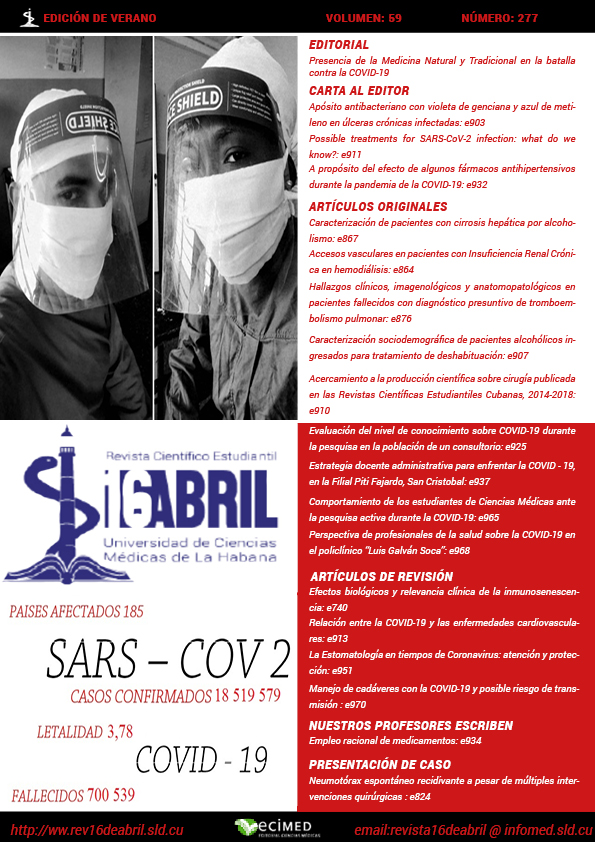Hallazgos clínicos, imagenológicos y anatomopatológicos en pacientes fallecidos con diagnóstico presuntivo de tromboembolismo pulmonar
Keywords:
diagnóstico, mortalidad, tromboembolismo pulmonarAbstract
Introducción: el tromboembolismo pulmonar es frecuente, potencialmente letal y puede tener dificultades diagnósticas.
Objetivo: caracterizar clínica, imagenológica y anatopatológicamente los pacientes fallecidos con diagnóstico presuntivo de tromboembolismo pulmonar.
Material y método: se realizó un estudio descriptivo transversal de los fallecidos con diagnóstico presuntivo de tromboembolismo pulmonar desde octubre de 2018 a octubre de 2019, en el Hospital Provincial Saturnino Lora. La muestra quedó conformada por 120 fallecidos. Se describieron variables como edad, sexo, factores predisponentes, principal síntoma o signo clínico, radiográfico y ecocardiográfico sugestivo de tromboembolismo así como el diagnóstico anatomopatológico confirmado o no de tromboembolismo.
Resultados: predominó los pacientes mayores de 60 años y el sexo femenino. La taquicardia (25,0%) y la disnea (33,3%) fueron los síntomas y signos más frecuentes en los casos confirmados. Según diagnóstico patológico predominó el infarto pulmonar en el 79,2% y el D-Dímero resultó positivo en todos los casos. Prevalecieron las aéreas radiológicas opacas (78,9%), la taquicardia sinusal (37,5%) y la dilatación y/o hipoquinesia del ventrículo derecho (45,5%)
Conclusión: El diagnóstico presuntivo de tromboembolismo y el diagnóstico anatomopatológico no fue coincidente en un número considerable de fallecidos.
References
2. Goncharova EA, Gladwin MT, Kawut SM. Update in pulmonary vascular diseas-es 2014. Am J Respir Crit Care Med. [Internet] 2015 [citado 10 Nov 2018]; 192 (5): 544-550. Disponible en: https://www.ncbi.nlm.nih.gov/pmc/articles/PMC4595695/
3. Blanco A, Luciardi H, Muntaner J. Trombosis: Principal causa global de morbi-mortalidad. Rev Fed Arg Cardiol [Internet]. 2015 [citado 11 Dic 2018]; 44(4): 188-9. Disponible en: http://moodle.fac.org.ar/2/revista/15v44n4/editorial/editorial01/blanco.pdf
4. Konstantinides SV, BarcoS, Lankeit M, Meyer G. Management of Pulmonary Embolism. An update. JACC [Internet]. 2016 [citado 11 Dic 2018]; 67(8): 976-90. Disponible en: https://www.ncbi.nlm.nih.gov/pubmed/26916489
5. Acosta Reynoso IM, Zayas Peña YA, Rodríguez Rojas Z, Manso López AM, Santiesteban Guerrero E. Análisis clínicoanatomopatológico de pacientes falle-cidos con tromboembolismo pulmonar. CCM [Internet] 2014 [citado 2018 dic 03]; 18(4): 636-48. Disponible en: http://scielo.sld.cu/scielo.php?script=sci_arttext&pid=S1560-43812014000400005
6. Triana Triana L, Puig Reyes I, Hernández Ortega R, González Alfonso O, Rodrí-guez Alvarez J, Nazco Hernández O, et al. Correlación clínico-patológica del tromboembolismo pulmonar en la cirugía cardiovascular. Cor Salud [Internet]. 2014 [citado 20 Ene 2019]; 6(3): 217-22. Disponible en: http://medicentro.sld.cu/index.php/corsalud/article/viewFile/1878/1475
7. Sandoval J. Florenzano VM. Diagnóstico y tratamiento del tromboembolismo pulmonar. Rev. Med. Clin. Condes [Internet]. 2015 [citado 20 Ene 2019]; 26(3): 338-43. Disponible en. http://ac.els-cdn.com/S0716864015000681/1-s2.0 S0716864015000681main.pdf?_tid=010f1de2-c6c4-11e5-8c08 00000aacb361&acdnat=1454098264_87bd2bf1eb53df3afeca32568a3ec66f
8. De Escalante YB, Oncins TR, Sampedro JA. La Casa MJ, Figueras PC, Najar SM. Descriptive study of autopsies of internal medicine department at the hospital of Barbastro and clinicopathological correlation. An Med Intern [Internet]. 2015 [ci-tado 20 Ene 2019]; 17(9):460-4. Disponible en: https://www.ncbi.nlm.nih.gov/pubmed/11100531
9. Deng X, Li Y, Zhou L, Liu C, Liu M, Ding N et al. Gender differences in the symptoms, signs, disease history, lesion position and pathophysiology in pa-tients with pulmonary embolism. PLoS One [Internet]. 2015 [citado 7 Feb 2019]; 10 (7): e0133993. Disponible en: https://journals.plos.org/plosone/article?id=10.1371/journal.pone.0133993
10. Bach AG, Taute BM, Baasai N, Wienke A, Meyer HJ, Schramm D et al. 30-day mortality in acute pulmonary embolism: prognostic value of clinical scores and anamnestic features. PLoS One [Internet]. 2016 [citado 7 Feb 2019]; 11 (2): e0148728. https://www.ncbi.nlm.nih.gov/pubmed/26866472
11. Guijarro R, Trujillo-Santos J, Bernal-Lopez MR, de Miguel-Díez J, Villalobos A, Salazar C et al. Trend and seasonality in hospitalizations for pulmonary embo-lism: atime-series analysis. J Thromb Haemost [Internet]. 2015 [citado 16 Feb 2019]; 13: 23-30. Disponible en: https://www.ncbi.nlm.nih.gov/pubmed/25363025
12. Stein PD, Matta F. Noninvasive imaging in pulmonary embolism according to age and gender. Clin Appl Thromb Hemost [Internet]. 2014 [citado 2 May 2019]; 20 (2): 143-146.65. Disponible en: https://www.ncbi.nlm.nih.gov/pubmed/23091281
13. Bustillo SE, Bustillo SI, Bustillo SJ. Tromboembolismo pulmonar e infarto pul-monar. Estudios de los casos fallecidos desde enero de 1976 a diciembre de 1980, ambos inclusive. Rev Cub Med [Internet]; 2000 [citado 2 May 2019] 22(6): 620 – 36. Disponible en: http://scielo.sld.cu/scielo.php?script=sci_arttext&pid=S1025-02551999000300004
14. Machado VL. Enfoque diagnóstico de la tromboembolia pulmonar. Acta méd. Grupo Ángeles [Internet]. 2017 [citado 2 May 2019]; 15(1): 36-46. Disponible en: http://www.scielo.org.mx/scielo.php?script=sci_arttext&pid=S1870-72032017000100036&lng=es.
15. Miniati M, Monti S, Bottai M. A structured clinical model for predicting the proba-bility of pulmonary embolism. Am J Med [Internet]. 2015 [citado 2 May 2019]; 114(3): 173 – 9. Disponible en: https://www.ncbi.nlm.nih.gov/pubmed/12637130
16. Carmona AJ. Diagnóstico del embolismo pulmonar, a propósito del Pioped II y de las nuevas técnicas isotópicas. Alasbimn J [Internet]. 2006 [citado 4 Oct 2019]; 9(34). Disponible en: http://www2.alasbimnjournal.cl/alasbimn/CDA/imprime/0,1208,PRT%253D18617,00.html.
17. Reina Gutiérrez L, Carrasco Carrasco JE. Recomendaciones sobre profilaxis, diagnóstico y tratamiento de la enfermedad tromboembólica venosa en Atención Primaria. Elsevier [Internet]. 2015 [citado 5 Dic 2019]; 67(5): 399-408. Disponible en: www.elsevier.es/angiologia
18. Patel UB, Ward TJ, Kadoch MA, Cham MD. Radiographic features of pulmonary embolism: Hampton’s hump. Postgrad Med J [Internet]. 2014 [citado 4 Oct 2019]; 90 (1065): 420-421. Disponible en: https://www.ncbi.nlm.nih.gov/pubmed/24894313
19. Abbas A, St Joseph EV, Mansour OMA, Peebles CR. Radiographic features of pulmonary embolism: Westermark and Palla signs. Postgrad Med J [Internet]. 2014 [citado 4 Oct 2019]; 90: 422-423. Disponible en: https://www.ncbi.nlm.nih.gov/pubmed/24906493
20. Zhan ZQ, Wang CQ, Nikus KC, He CR, Wang J, Mao S et al. Electrocar-diogram patterns during hemodynamic instability in patients with acute pulmonary em-bolism. Ann Noninvasive Electrocardiol [Internet]. 2014 [citado 4 Oct 2019]; 19 (6): 543-551. Disponible en: https://www.ncbi.nlm.nih.gov/pubmed/24750207
Downloads
Published
How to Cite
Issue
Section
License
Those authors who have publications with this journal, accept the following terms:
The authors will retain their copyright and guarantee the journal the right of first publication of your work, which will be under a Creative license Commons Attribution-NonCommercial-ShareAlike 4.0 International . (CC BY-NC-SA 4.0).
The authors may adopt other non-exclusive license agreements for the distribution of the published version of the work (eg:deposit it in an institutional telemat








